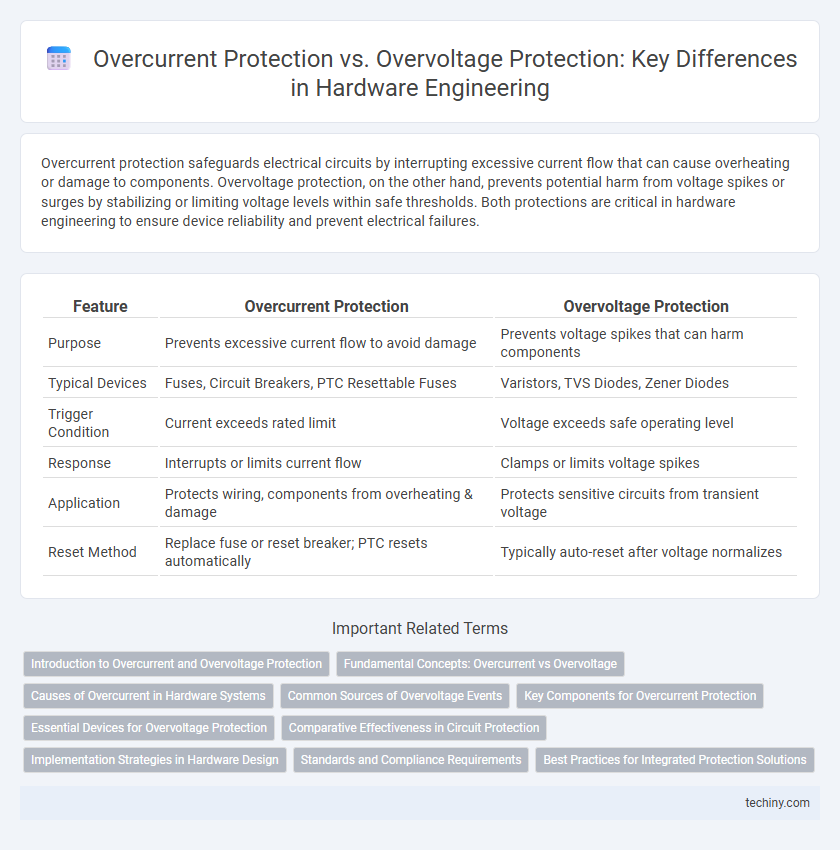Overcurrent protection safeguards electrical circuits by interrupting excessive current flow that can cause overheating or damage to components. Overvoltage protection, on the other hand, prevents potential harm from voltage spikes or surges by stabilizing or limiting voltage levels within safe thresholds. Both protections are critical in hardware engineering to ensure device reliability and prevent electrical failures.
Table of Comparison
| Feature | Overcurrent Protection | Overvoltage Protection |
|---|---|---|
| Purpose | Prevents excessive current flow to avoid damage | Prevents voltage spikes that can harm components |
| Typical Devices | Fuses, Circuit Breakers, PTC Resettable Fuses | Varistors, TVS Diodes, Zener Diodes |
| Trigger Condition | Current exceeds rated limit | Voltage exceeds safe operating level |
| Response | Interrupts or limits current flow | Clamps or limits voltage spikes |
| Application | Protects wiring, components from overheating & damage | Protects sensitive circuits from transient voltage |
| Reset Method | Replace fuse or reset breaker; PTC resets automatically | Typically auto-reset after voltage normalizes |
Introduction to Overcurrent and Overvoltage Protection
Overcurrent protection safeguards electrical circuits by detecting and interrupting excessive current flow that can cause damage or hazards, utilizing devices such as fuses and circuit breakers. Overvoltage protection prevents damage from voltage spikes and transient surges by employing components like metal-oxide varistors (MOVs) and surge protectors, which clamp or divert excess voltage. Both protection methods are crucial in hardware engineering to maintain device integrity, enhance safety, and ensure reliable operation of electronic systems.
Fundamental Concepts: Overcurrent vs Overvoltage
Overcurrent protection safeguards circuits by detecting excessive current flow that exceeds the rated capacity, preventing damage from overheating or component failure. Overvoltage protection targets voltage spikes or surges above the designated threshold, protecting sensitive components from insulation breakdown or electrical overstress. Both mechanisms are essential in maintaining hardware reliability, with overcurrent focusing on current limits and overvoltage addressing voltage anomalies in electronic systems.
Causes of Overcurrent in Hardware Systems
Overcurrent in hardware systems typically arises from short circuits, excessive load conditions, or component failures that cause current to exceed safe operating limits. Faulty wiring, damaged connectors, and sudden surges from power supplies often contribute to overcurrent events, risking component damage or thermal stress. Effective overcurrent protection relies on detecting these abnormal current flows and disconnecting power before irreversible harm occurs.
Common Sources of Overvoltage Events
Common sources of overvoltage events in hardware engineering include lightning strikes, power surges from electrical grid fluctuations, and inductive load switching. These events can cause transient voltage spikes that exceed device ratings, leading to component failure or system instability. Implementing effective overvoltage protection strategies such as surge protection devices and voltage clamping is essential to safeguard sensitive electronics.
Key Components for Overcurrent Protection
Key components for overcurrent protection include fuses, circuit breakers, and current sensors, each designed to detect and interrupt excessive current flow to prevent damage. Fuses provide a simple, sacrificial method by melting conductive material when current exceeds a threshold, while circuit breakers offer reusable protection by mechanically disconnecting the circuit. Current sensors, such as Hall effect sensors or shunt resistors, enable real-time monitoring and trigger protective responses in advanced electronic systems.
Essential Devices for Overvoltage Protection
Essential devices for overvoltage protection in hardware engineering include transient voltage suppressors (TVS), metal oxide varistors (MOV), and gas discharge tubes (GDT). These components safeguard electronic circuits by clamping or diverting excessive voltage spikes caused by lightning, switching surges, or electrostatic discharge. Proper selection and integration of these devices enhance system reliability and prevent catastrophic damage to sensitive hardware components.
Comparative Effectiveness in Circuit Protection
Overcurrent protection primarily safeguards circuits by interrupting excessive current flows that can cause overheating and damage, whereas overvoltage protection limits voltage spikes that may degrade component insulation and lead to breakdowns. Overcurrent devices like fuses and circuit breakers react to harmful currents but may not prevent transient voltage surges, while overvoltage protection using MOVs and TVS diodes effectively clamps voltage spikes, preventing insulation stress. Comparative effectiveness depends on circuit vulnerability: overcurrent protection excels in preventing thermal damage, whereas overvoltage protection is critical for transient suppression, making integrated solutions ideal for comprehensive circuit defense.
Implementation Strategies in Hardware Design
Overcurrent protection in hardware design typically employs current sensing components such as shunt resistors or Hall-effect sensors integrated with fast-acting circuit breakers or electronic fuses to immediately interrupt excessive currents and prevent damage. Overvoltage protection strategies rely on voltage clamps like transient-voltage-suppression diodes, metal-oxide varistors, or zener diodes, which divert or limit voltage spikes to safe levels. Effective implementation requires careful selection of sensing thresholds and response times tailored to the specific electrical characteristics of the circuit to ensure reliable and precise safeguarding against both current and voltage anomalies.
Standards and Compliance Requirements
Overcurrent protection in hardware engineering must comply with standards such as UL 1449 and IEC 61000-4-5, ensuring safe current limits to prevent circuit damage and fire hazards. Overvoltage protection devices adhere to regulations like IEC 62305 and IEEE C62.41 to mitigate voltage spikes and transient surges, safeguarding sensitive electronic components. Both protection types require compliance with industry-specific certifications to guarantee reliable performance and regulatory approval in commercial and industrial hardware applications.
Best Practices for Integrated Protection Solutions
Implementing integrated protection solutions requires selecting components that combine overcurrent protection (OCP) and overvoltage protection (OVP) functionalities to ensure comprehensive circuit safety. Best practices include utilizing polyswitch resettable fuses or PTC devices for OCP alongside transient voltage suppressors (TVS) diodes or metal oxide varistors (MOVs) for OVP, optimizing response times and minimizing false triggers. Designing with precise current and voltage threshold settings tailored to the application enhances reliability and reduces damage from electrical faults.
Overcurrent Protection vs Overvoltage Protection Infographic

 techiny.com
techiny.com